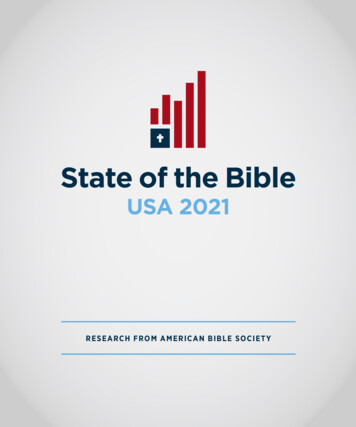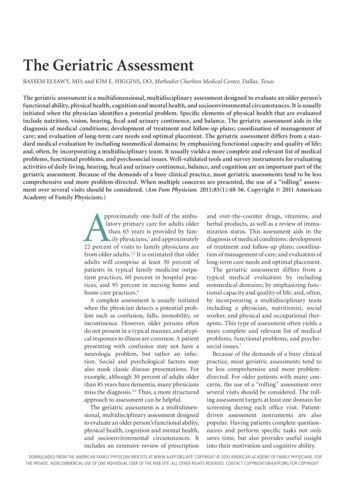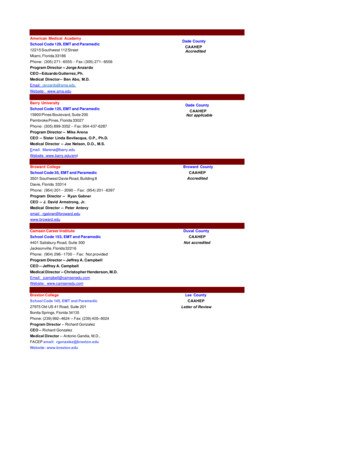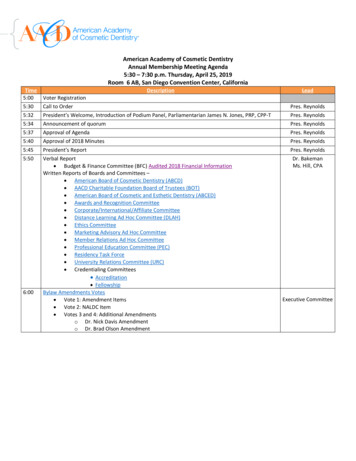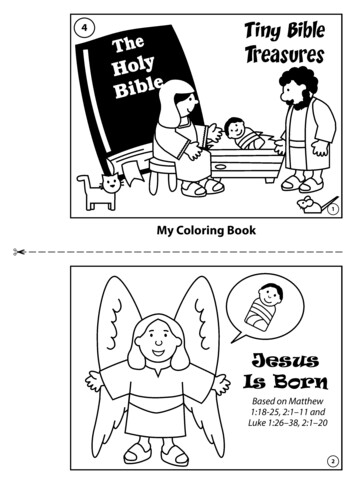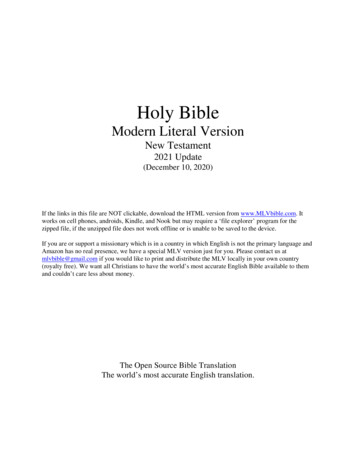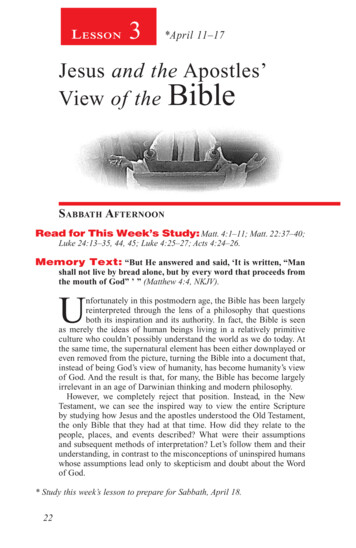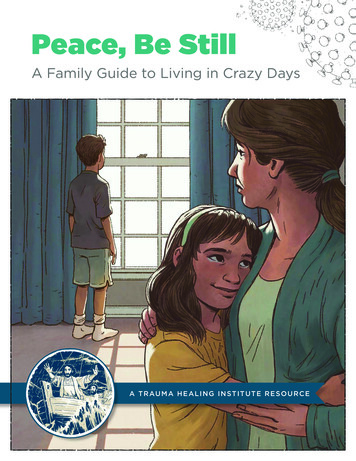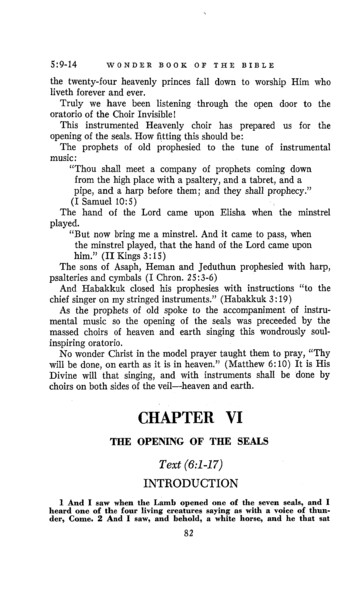
Transcription
5:9-14WONDER BOOKOF THE BIBLEthe twenty-four heavenly princes fall down to worship Him wholiveth forever and ever.Truly we have been listening through the open door to theoratorio of the Choir Invisible IThis instrumented Heavenly choir has prepared us for theopening of the seals. How fitting this should be:The prophets of old prophesied to the tune of instrumentalmusic :“Thou shall meet a company of prophets coming downfrom the high place with a psaltery, and a tabret, and apipe, and a harp before them; and they shall prophecy.”(I Samuel 10:5)The hand of the Lord came upon Elisha when the minstrelplayed.“But now bring me a minstrel. And it came to pass, whenthe minstrel played, that the hand of the Lord came uponhim.” ( I 1 Kings 3 :15)The sons of Asaph, Heman and Jeduthun prophesied with harp,psalteries and cymbals (I Chron. 25:3-6)And Habakkuk closed his prophesies with instructions “to thechief singer on my stringed instruments.” (Habakkuk 3: 19)As the prophets of old spoke to the accompaniment of instrumental music so the opening of the seals was preceeded by themassed choirs of heaven and earth singing this wondrously soulinspiring oratorio.No wonder Christ in the model prayer taught them to pray, “Thywill be done, on earth as it is in heaven.” (Matthew 6: 10) I t is HisDivine will that singing, and with instruments shall be done bychoirs on both sides of the veil-heaven and earth.CHAPTER VITHE OPENING OF THE SEALSText (6:l-17)INTRODUCTION1 And I saw when the Lamb opened one of the seven seals, and Iheard one of the four living creatures saying as with a voice of thunder, Come. 2 And I saw, and behold, a white horse, and he that sat82
WONDER BOOK OF T H E DIBLE6:l-17thereon had a bow; and there was given unto hiin a crown: and h ecame forth conquering, and to conquer.3 And when he opened the sccond seal, I heard tlie second livingcreature saying, Come. 48 And another horsc came forth, a red hoi*se:and to him that sat thereon it was given to take peace from the earth,and that they should slay one another: and there was given unto hima great sword.5 And when h e opened the third seal, I heard the third livingcreature saying, Come. And I saw, and behold, a black horse; and h ethat sat thereon had a balance in his hand. G And I heard as it werea voice in the midst of the four living creatures saying, A measureof wheat for a shilling, and three measures of barley for a shilling;and the oil and the wine hurt thou not.7 And when he opened the fourth seal, I heard the voice of thefourth living creature saying, Come. 8 And I saw, and behold, a palehorse: and he that sat upon him, his name was Death; and Hadesfollowed with him. And tliere was given unto thein authority over thefourth part of the earth, to kill with sword, and with famine, andwith death, and by the wild beasts of tlie earth.9 And when he opened tlie fifth seal, I saw underneath the altarthe souls of them that had been slain for the word of God, and forthe testimony which they held: 10 and they cried with a great voice,saying, How long, 0 Master, the holy and true, dost thou not judgeand avenge our blood on them that dwell on the earth? 11 And therewas given them to each one a white robe; and it was said unto theni,that they should rest yet for a little time, until their fellow-servantsalso and their brethren, who should be killed even as they were,should have fulfilled their course.12 And I saw when he opened the sixth seal, and there was a greatearthquake; and the sun became black a s sackcloth of hair, and thewhole moon became as blood; 13 and the stars of the heaven fellunto the earth, as a fig tree easteth her unripe figs when she isshaken of a great wind. 14 And the heaven was removed as a scrollwhen it is rolled u p ; and every mountain and island were moved outof their places. 15 And the kings of the earth, and the princes, andthe chief captains, and the rich, and tlie strong, and every bondmanand freeman, hid themselves in the caves and in the rocks of themountains; 16 and they say to the mountains and to the rocks, Fallon us, and hide us from the face of him that sitteth on the throne,and from the wrath of the Lawb: 17 for the great day of their wrathis come; and who is able to stand?In this chapter it is given to us to see how the Redeemer proceedsto exercise the power or authority bestowed upon Him. He openssix seals in succession, after which the dramatic action is interrupted by a separate vision of the four angels standing on the fourcorners of the earth (Rev. 7 : l ) . The seventh seal is not discribeduntil the eight chapter is reached.Since this book was in scroll form, which was a long strip ofparchment rolled up and sealed with seven seals, our understandingis that Christ breaks the first seal, thus revealing the words writtenin the scroll as Ear as the second seal. He then opens the second seal83
6: 1-17WONDER BOOK OFTHE BIBLEand further unrolls the scroll. This He continues until the scroll iscompletely unrolled.The unrolling of the scroll has these effects: First, it uncovers toview the hidden purposes of God, and second, it reveals the successive events whereby His purposes are accomplished.We must constantly keep in mind the scope of Revelation, that itis limited. I t does not attempt to reveal the future history of allnations, but deals with future history of the church and those opposing powers that affected the fortunes of the Bride of Christ.Since the church, at the starting point of this vision-theenthronement of Christ at the right hand of God-is wholly withinthe confines of the vast persecuting empire of pagan Rome, welogically and rightfully understand the events of these seals begin inthe Roman empire nearest to the starting point of time and continuethrough the seventh seal where the remotest events are chronicled.We must ever remember there was being revealed “things whichshortly must come to pass.” Therefore, the events of this visiondo not refer to things somewhere in the distant future. Also Johnwas to “write the things which thou hast seen, and the things whichare, and the things which shall be hereafter.”And these things are recorded in the Book of Revelation-a bookwhich is written in the language of signs. He sent and “signified” it--Sign-i-fied it, that is communicated it by signs to His servantJohn.Thus we must move slowly in the “uncovering” of the symbolscontained in the seven seals. In determining the meaning of thisseries of prophetic symbols, protraying events which follow successively, it is of supreme importance to correctly interpret the firstseal. A wrong start will lead us astray throughout the unrolling ofthis scroll.Certainly we are not to spiritualize these visions because John, aswe have seen already, was to write the things he had seen, the thingswhich are and the things which shall be hereafter. If language meansany thing, then these are actual, historical events.These seals uncover a series of events affecting the fortunes of thechurch, but also immediately connected with the vast Roman empirein whose confines the church lived and moved and had her being.These are visions of peace and war, of famine and death, of thepersecution of the church and the judgments with which this agewill end.a4
WONDER BOOK OF THE BIBLE6:1,2The First SealVS. 1, 2 As this first seal is broken, John heard the voice of one ofthe four living creatures saying with a voice of thunder, “Comeand see.”Beginning with the breaking of this first seal we note that thefirst living creature speaks, and with the opening of each suceedingseal another one of the four living creatures speak.With the opening of this first seal, as well as the next three seals,the contents of the boolr are not read, but its messages are translatedinto action.In response to the invitation to come and see, immediately Johnbeholds ‘(a white horse and he that sat thereon had a bow, and acrown was given him and he went forth conguering and to conquer.There are a number of features to this vision.First, our attention is called to a horse. We are to remember thatthis is a symbol and the Bible must be consulted to interpret itsmeaning. The horse is a symbol of war. H e was never used by eitherthe Jews or the orientals as a beast of burden; the ox and the asswere used for that purpose. The horse was always reserved for war.Shall we turn to the Old Testament for our interpretation of thissymbol, for the horse is not mentioned in the New Testament, exceptin Revelation. We discover that the horse is first of all the symbolof strength of a certain kind; not strength for labor like the ox, orfor the mastery of enemies, like the lion, but a symbol of might orconquest. Especially does it typify strength and courage for conflict.I n (Job 3 9 : 1 9 - 2 3 ) the description of a horse pertains to qualitiesthat have to do with war. God in addressing Job said, “Hast thougiven the horse strength? Hast thou clothed his neck with thunder?Canst thou make him afraid as a grasshopper? The glory of hisnostrils is terrible. He paweth in the valley and rejoiceth in hisstrength. He goeth on to meet the armed men . . . neither turnethhe back from the sword.”In the 25th verse of this same chapter we read, “He saith amongthe trumpets Ha, H a ; and he smelleth the battle afar off, thethunder of his captains, and the shouting.”I n the song of Moses on the far side of the Red Sea, we read, “Iwill sing unto the Lord, for He hath triumphed gloriously: thehorse and his rider hath He thrown into the sea.” (Ex. 15: 1)85
6 : 1,2WONDERBOOK OFTHE BIBLEFrom this we learn that the horse represents the progress of somegreat force or eause backed by strong military power.Bearing in mind the significance of the horse as a Bible symbol,this first horse, as well as the remaining three are prophetic picturesof mighty military forces and campaigns beginning with the timeof the enthroning of Christ on the right hand of God and continuingone after the other.Second, “A white horse.” Since there are three more horses in thethree remaining seals, each of different colors, each color must holdsome very significant meaning.The white horse here must have an altogether different signification from the red, black or pale colorations. White was, then in thearena of war a symbol of victory, prosperity and joy. I t was a symbolof triumphant war.When a Roman general returned from victorious campaigns in thefar-flung frontiers of the empire he halted with out the city walls ofRome until the senate voted the manner of his entry. If that bodyvoted that the general was entitled to a triumphantal entry, snowywhite horses were hitched to his chariot and drawn through thestreets of the imperial city, followed by a long line of captivegenerals, slaves and spoils of war.Third, the armed warrior. We know this was a military figure because he carried a bow, a weapon of war. The symbolism herepoints to a period of triumphant war.Fourth, the bow. There were bowmen in all ancient armies, butthe prominence given the bow here would seem to point to a particular race of people.Fifth ,“A crown was given Him.” The crown upon this rider indicates that he shall be a crowned monarch. And note carefully thathe is not crowned because of his conquests, but it was given himbefore these victories.Sixth, His mission. “He went forth conquering and to conquer.”Having now determined the meaning of these symbols it now isour task to discover if “shortly” after John wrote, history recordsevents which correspond to these symbols.At the time John penned this ‘(uncovering” of things he had seen,which are, and which are to come to pass shortly, a great Romangeneral was successfully extending the borders of the empire to itsgreatest bounds. He truly “went forth conquering, and to conquer.Hear Myers on this:86
WONDER1BOOKOF TEE BIBLE6: 1,2“To Trajan belongs the distinction of having extended theboundaries to the most distant points to which Roman ambition and prowess were ever able to push them.”-MyersAncient History-Page 506.A grateful emperor erected a memorial to Trajan’s achievementsin what came to be known as Trajan’s Forum, a splendid marbleshaft called Trajan’s Column. The stately pillar is almost as perfecttoday as when reared nineteen centuries ago.Trajan’s reign marked not only an age of conquest and victory,symbolized by the white horse and his rider, but also an age ofinternal peace and prosperity. I have before me Volume I of Gibbon’s Rome edited by Milman. On Pages 95, 96 we read:[‘Ifa man were called to fix the period in the history of theworld, during which the condition of the human race wasmost happy and prosperous, he would without hesitation,name that which elapsed from the death of Domitian to theaccession of Commodus. The vast extent of the Roman empire was governed by absolute power, under the guidance ofvirtue and wisdom. The armies were restrained by the firmbut gentle hand of four successive emperors, whose characters and authority commanded involuntary respect. Theforms of civil adminstration were carefully preserved byNerva, Tragan, Hadrian, and the Antonines, who delightedin the image of liberty.”Of these four, Trajan, who ascended the throne four years afterthe death of Domitian, is the most outstanding. The symbols of thisfirst seal are strikingly fulfilled in this epoch of Roman history, Itfurnished one of the greatest conquerors of the Roman Empire, and,a t a time which fits into this vision on Patmos. Trajan was a crownedconqueror, as revealed in this vision and went forth conquering andto conquer. Since the scope of John’s prophecy falls within theRoman empire, all events of this epoch correspond to the divinerevelation.Particularly, one feature of this vision is significantly fitting. Therider of this white horse-the symbol of military conquest-wasarmed with a BOWI At first this would seem contradictoy evidence,for the bow was not a Roman weapon. Rome ever conquered withthe sword, carrying into battle the javelin for longer range fighting,but the sword to be used in close quarters. There were bowmen inthe Roman legions, but they were not Romans. The use of the bowas a symbol is quite enlightening.87
6:1-4WONDER BOOKOF T H E BIBLEThere were two nations on the earth at the time of this revelationwho were renowned as users of the bow. The bow was the militaryweapon of the Parthians beyond the Euphrates, and of the Cretans,dwellers of the island of Crete. Cretan bowmen were constantlyfeatured in Grecian history.So the bow, the weapon carried by this first rider, must signifysome one whose ancestry was rooted in Crete. How amazingly accurate this symbol is to history! If a Roman had been symbolizedin this rider, he would not be represented armed with a bow. Thebow points us to some one of another nation rather than that ofRome. And history supplies us with the answer.Beginning with Julius Caesar, the twelve Caesars who reignedover the Roman empire were all of pure Roman blood. Domitian, theone who exiled John to Patmos, was the last of the twelve Caesars.He was followed on the throne by Nerva, the founder of a line thatsupplied five Caesars in succession.The five “good emperors” as they came to be known, were Nerva,Trajan, Hadrian and the two Antonines-Aurelius Antoninus andMarcus Aurelius. They reigned from A.D. 96 to A.D. 180.Nerva, the first of this new line of emperors was not of Romanblood. Cassius, a historian of that day declares that Nerva was aGreek and Aurelius Victor, another Roman Historian says thatNerva’s family came from the Grecian island of Crete.Already we know that the national weapon of the Cretans wasthe bow. The Cretans were as famous for their skill with the bow asthe Rhodians were for their use of the sling, or the Romans with thejavelin and short sword.We cannot note to carefully that the founder of this new familyof emperors, was an alien-the first to ever rule Rome. His familywas of Cretan blood and the national weapon of the islanders ofCrete was the bowlThe Second Sealvs. 3, 4 “And when he had opened the second seal, I heard thesecond living creature say, “come and see” The second cherubimrepeats the command of the first living creature, (‘Come and see.”vs. 4 At once the first vision makes way for a second, “Andthere went out another horse that was red.” This horse, also representing some great military force, naturally symbolizes, chronologically, the next series of events following those of the first seal.But the horse is no longer white, but red. The horse is the symbol88
WONDER BOOK OF T H E BIBLE6:4of war, but the changed color points t o the fact that the conditionsof war are entirely changed. It would seem to indicate that nowthe stage of the conflict has brought blood shed within the empire.Whereas the white horse symbolized peace, prosperity and victorywithin the Roman empire, now blood shed invades her borders.It is a fact in history that during the period of the first sealthrough the reigns of “the five good emperors”-the Roman Empirenever saw the forces of an invading army. All conquests were wagedin the countries of her enemies, for Rome was going forth conqueringand to conquer.Under the strong but mild rule of Trajan, Hadrian and the Antonies, every man dwelled safely under his own vine and fig tree. Nohostile invasion or internal upheavals ever troubled the tiller of thesoil or the artisan of trade. The first seal was a period of triumphantwar, but of internal peace.The second seal indicates from its very opening the continuedexistence of war. Internal peace has vanished. The first and secondhorsemen are strikingly contrasted. The first horsemen representspeace though there was outside war, but the second horse symbolizescivil war and bloodshed.This is all the more emphasized because this is a blood-red horse,“And power was given unto him that sat thereon to take peacefrom the earth.” The earth spoken of by John would be the RomanEmpire, for the empire was the last great world empire as seen byDaniel, and the scope of Revelation always contemplates thisworld power.I n this epoch, peace is taken from the empire and we know thispeace has been lost through civil war by the phrase, “That theyshould kill one another.” This is in as plain language as symbolismcan speak.As the first seal of peace was substantiated by corroborating history, so we may expect to find further events of history correspond’ngto the symbolism of this second seal. This we find to be abundantlytrue.At the close of the reign of Conmodus we find the end of peacein the Roman empire. Commodus was slain. As son of MarcusAurelius, the last of the Antonines, he proved to be a most unworthysuccessor of his illustrous father. For three years he reigned well,but an unsuccessful attempt against his life, three years after hisascension to the throne seemed suddenly to kindle all the dormant89
6:4WONDER BOOKO F THE BIBLEpassions of a Nero. The remaining ten years of his reign were markedby the perpetration of all manner of cruelties and the staining of theimperial purple with the most detestable debaucheries and crimes.The empire was finally relieved of this insane tyrant by somemembers of the royal household who put him to death. This begana reign of civil war. Hear Myers on this:“For nearly a century after the death of Commodus (192to 284 A.D.) the emperors were elected by the army, andhence the rulers of this period have been called, “The Barrack Emperors.” Upon the death of Commodus, Pertinax,a distinguished senator, was placed on the throne; but hisefforts to enforce discipline among the praetorians arousedtheir anger, and he was slain by them after a short reign ofonly three months. The soldiers then gave out notice thatthey would sell the empire to the highest bidder. I t was accordhgly set up for sale at the praetorian camp and struckoff to Didius Julianius, a wealthy senator, who promisedtwenty-five thousand sesterces to each of the twelve thousand soldiers at this time composing the guard. So the priceof the empire was three hundred million sesterces (about 1 2,000,000) .-Myers Ancient history P. 5 15.This gives us a preview of what lay in store for the empire.During this period of the national history thirty-two emperors, andtwenty-seven pretenders alternately hurled each other from thethrone. Hear Sismondi:“With Commodus commenced the third and most calamitous period, I t lasted ninety-two years, from 192 to 284.During that period thirty-two emperors, and twenty-sevenpretenders alternately hurled each other from the throne byincessant civil warfare. Ninety-two years of almost incessant civil warfare taught the world on what a frail foundation the virtue of the Antonines had placed the felicity ofthe empire.”-Sismondi’s Fall of the Roman Empire Vol.1, P. 36.Gibbon in the first volume of his Decline and Fall of the RomanEmpire devotes two hundred pages to the description of this “RedHorse” period of civil strife and rapine.Of these thirty-two emperors, besides the pretenders only two diednatural deaths; Severus, who died 211 A.D. and Volusion who died253 A.D. All others died violent deaths.90
WONDER BOOK OF T H E B I B L E6:4-6What could more fittingly represent a period of fratricidal bloodshed and rapine, of constant civil war, than a red horse and its rider“to whom was given a great sword, and the power to take awaypeace, that men should lrill one another?”We wish to further consider the giving of that “great sword.” Thebow is gone now, which was the emblem of an alien, and a sword,the national weapon of Rome, replaces it.This sword marks some special feature of the fulfillment of theevents of the seal, I t points to an epoch when the jealous ambitionsof men of the sword drove them to brutality and murder.There were stationed at Rome an army corps which outranked allothers. We have already referred to them as the Praetorian guardsand recounted their sale of the empire to Didius Julianius. I t was anorder in which the Praetorian Perfect was inducted into office by thepublic investment with a sword. I t was the Praelorian Perfect andhis guard that inaugurated this century of bloodshed.What could more fittingly describe such a period, as portrayedunder the second seal, than the giving of a great sword, the militaryemblem, to the figure that rides the red horse of John’s prophecy?The Third Sealvs. 5, 6 Famine always follows war, and particularly civil war withits internal devastation of men, materials, industry and food production.Therefore, it is only natural that we should read when the thirdseal was opened: “I heard the third living creature say, come andsee. And I beheld, and lo a black horse; and he that sat on him hada pair of balances in his hand. And I heard a voice in the midst ofthe four living creatures say, a measure of wheat for a penny:and see thou hurt not the oil and the wine.”How natural that the period of civil war, indicated by the redhorse, a period of bloodshed and anarchy should produce eventssymbolized by a black horse.The horse, whatever his color, is a symbol of war, the change incolor only signifies a changed aspect of that war. Black wouldindicate that the empire is still torn by calamitous war, but warthat brought mourning and despair. Black has ever been the colorof mourning in Scriptural usage. Jeremiah said: “Because of the91
6: 5,6WONDER BOOKOF THE BIBLEdrought Judah mourneth, and the gate thereof languish; they are indeep mourning (literally black) for the land.” (Jer. 14: 2 )After noting the color of the horse, recognition is given to the factthat “he that sat on him had a pair of balances in his hand.” Ifthe balances were presented alone, we might see in them a symbol ofjustice, but in the hands of the rider of the black horse, and in connection with the weighing of grain that follows, they undoubtedlyindicate a period characterized by scarcity of food.The significance of balances in relation to food is made clear inthe Scriptures. “And when I have broken the staff of your bread,the women shall bake your bread in one oven, and they shall deliver your bread again by weights and ye shall eat and not besatisfied” (Lev. 26:26)“Moreover he said unto me, son of man, behold, I will break thestaff of bread in Jerusalem: and they shall eat bread by weight,and with care; and they shall drink water by measure and withastonishment: That they may want bread and water and be astonished with one another, and consume away for their iniquity.”(Ezelr. 4: 16, 17)The prices quoted here for wheat and barley are famine prices.The “measure” spoken of here was, roughly speaking, the equivolentof our quart, and the word rendered “penny” is the Greek “denarius,” which equals about fourteen cents in our money. A bushelof wheat, at the price designated would be nearly five dollars, and abushel of barley one dollar and fifty cents.A denarius was the usual rate for one day’s labor. I n our money,considering the rate of exchange, that would mean a bushel of wheatcost about twenty dollars and a bushel of barley shows that richand poor alike were affected, because wheat was the grain of therich and barley the staff of the poor.Since oil and wine were common articles of food for the people,the prohibition of their use, taken in connection with the contextwould seem to imply that at this time these items were no longerused by the common people.But balances were also, in that day, employed in taxation. Aportion of the production of the land was a part of the taxes extorted by the Roman empire. The balances then would symbolize aperiod of excessive taxation, as well as scarcity.This heavy taxation began even in the days of the second sealperiod when Caracalla granted Roman citizenship to multitudes in hisempire in order to tax the more persons.92
6: 5,6WONDER BOOK OP T H E BIBLE“CaracaIla’s sole political act of real importance was thebestowal of citizenship upon all the free inhabitants of theempire; and this he did, not. to give them a just privilege,but that he might collect from them certain special taxeswhich only Roman citizens had t o pay.”-Myers AncientIlistory P. 5 17But with the death of the last emperor of the third seal period,Carinus in 284, a new type of government was inaugurated byDiocletain. The change was marked by Diocletian’s assumption ofthe titles of Asiatic royalty and court ceremonials. Ostentation andextravagance marked all the appointments of the palace. He alsoinaugurated a new administrative system.“The century of anarchy which preceded the ascension of Diocletian; had made manifest the need of a system which woulddiscourage assassination and provide a regular mode of succession to the throne. Diocletian devised a system the aimof which was to compass both ends. First, he chose as acolleague a companion ruler, Maximian, who, like himself,bore the title of Augustus. Then each of the co-emperors associated with himself an assistant, who took the title of Caesarand was considered the son of the Emperor. There were thus twoAugusti and two Caesars. (From the number of rulers, thisgovernment has received the name of Tetrarchy) . . a mostserious drawback to this system was the heavy expense involved in the maintenance of four courts with their endlessretinue of officers and dependents. It was complained that thenumber of those who received the revenues of the state wasgreater than those that contributed to them. The burden oftaxation grew unendurable. Husbandry in some regions ceasedand great numbers were reduced to beggary or driven intobrigandage . , . it was this vicious system of taxation whichmore than any other one cause, after slavery, contributed tothe depopulation, improverishment and final downfall of thenation.” Myers’ Ancient History Pages 521, 522.This feature of taxation is peculiar to the third seal. A quotation ortwo will suffice. This taxation began even in the second seal, butreached such ruinous proportions in the third seal as to render it anoutstanding feature of that epoch. Gibbon speaks of the beginning ofsuch taxation under Caracalla. (A.D. 211-217)“Nor was the rapacious son of Severus (CaracalIa) contented.93
6:s-8WONDERBOOK OFTHE BIBLEwith such a measure of taxation as had appeared sufficient tohis moderate predecessors. Instead of a twentieth, he exacted atenth of all legacies and inheritances, and during his reign hecrushed alike every part of the empire under the weight of hisiron scepter.”-Gibbon’s Decline and Fall of Rome Vol. , P.95.Lactantius, a n historian of the fourth century recorded:“Swarms of exactors sent into the provinces, filled them withagitation and terror, as though a conquering enemy were leading them into captivity. The fields were separately measured,the trees and vines, the flocks and herds were numbered, andan examination made of men . . . the sick and the weak wereborne to the place of inscription, a reckoning was made of theage of each, years were added to the young and subtracted fromthe old, in order to subject them to the higher taxation the lawimposed. The whole scene was filled with wailing and sadness.”-Lactantius.Surely, no more impressive or expressive symbol, than a blackhorse, indicating mourning, and its rider holding a pair of balancesin his hand, indicative of famine, could have properly described theepoch covered by the third seal.The Fourth Sealvs. 7, 8 “And when he had opened the fourth seal, I heard thevoice of the fourth living creature say. “Come and see.” And Ilooked, and behold a pale horse: and his name that sat on himwas Death, and Hell followed with him. And power was given untothem over the fourth part of the earth, to kill with sword, and withhunger, and with death, and with beasts of the earth.”The conditions under the fourth seal reach the worst. The color ofthe fourth horse is pale. Remembering the horse is ever a symbolof war, whatever its color, we are by the continued use of the symbolof the horse reminded that it is still a time of war. The color of thehorse now b
8 And I saw, and behold, a pale horse: and he that sat upon him, his name was Death; and Hades followed with him. And tliere was given unto thein authority over the . Bearing in mind the significance of the horse as a Bible symbol, this first horse
